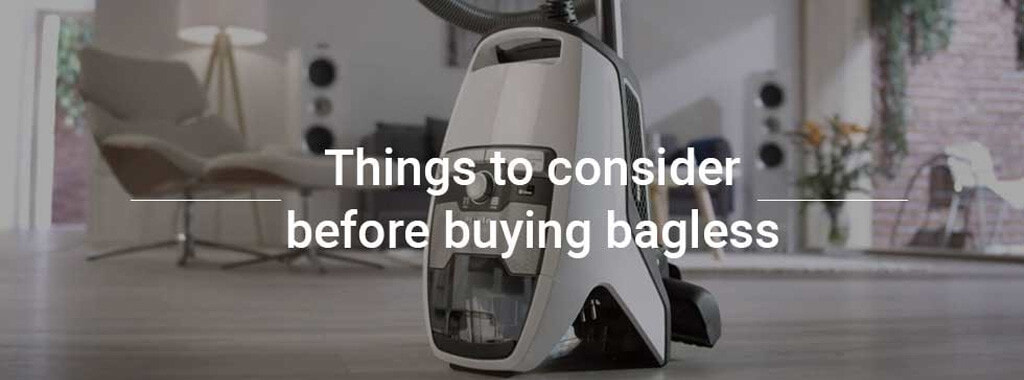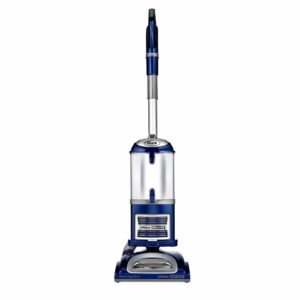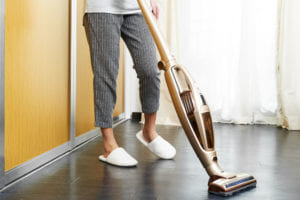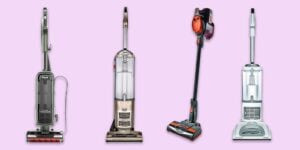Which Vacuum is Best: Bagged or Bagless?
It’s time to buy a new vacuum cleaner. That shouldn’t be difficult, right? Modern vacuums come in many shapes and variations. Do you buy an upright, a canister, or maybe you want a stick? These are all valid questions that spring to mind when considering what to purchase, but one that proves a sticking point for many vacuum purchasers is whether to opt for a bagged or bagless model.
Once you strip away the budget, the size, the style of vacuum and the manufacturer, it still comes down to the simple question: Bagged or Bagless? What is the difference between the two? Bagged and bagless vacuum cleaners have similar performance levels. They look similar and, budget depending, they cost the same. The real difference is how they help you dispose of all that dust once you’ve vacuumed the house.
To elaborate on this crucial element, this article takes our readers on a journey into the pros and cons of both bagged and bagless vacuums.

Bagged vacuum cleaners are the most traditional models that have a bag that sits inside the main body of the vacuum and can be easily removed and disposed of when it’s full. The designs have changed substantially, but the principle remains the same: to suck up dust and house it in a bag contained inside. Why is a bagged vacuum a good idea?
- Allergies: If you suffer from allergies then bagged might be for you. They are hygienic because all that dust and dirt is sucked up and trapped inside a sealed bag. You don’t have to shake it out over a trash can, so almost none of those nasty particles are going to cause you to sneeze until your eyes feel like they’re about to pop out; just replace the old bag with a new one and you’re ready to start vacuuming again. The other advantage with a bagged vacuum cleaner is that the filter needs replacing less than on a bagless vacuum, because, unlike bagless, the dust and allergens are stored safely in the bag and not in a chamber.
- Hygiene: Bagged vacuums are by far the most hygienic. Unlike the bagless models, you never come into contact with the harmful particles of dust. Some bagged vacuum cleaners offer the option of a two-bagged hypoallergenic system. This system uses an outer and an inner bag. The outer bag acts like a filter, drawing allergens out of the air. The inner bag is sealed and disposable.
- Filters: Many bagged vacuum cleaners come equipped with a High Efficiency Particulate Air (HEPA) filter system are recommended because they trap 99.97 percent of particulates 0.3 microns or larger. HEPA is the industry accepted standard for the best filters, so if you can afford a vacuum with a HEPA filter, it is worth spending that little bit more.
- Maintenance: Like all technology, with moving parts, at some point, you will need to fix something. But the chances of there being a problem with a bagged vacuum are significantly less than a bagless vacuum because the bagged vacuum has a greater dust storage capacity, thereby reducing the frequency of dismantling it and emptying the debris. The plastic construction on some of the budget end bagless vacuums isn’t that robust. With a bagged vacuum you might empty the bag once a week, or maybe every two weeks, but with a bagless vacuum, you’d be emptying it every day, or at the very least, every other day, and that increases the wear and tear and the chances of something breaking.

Bagged vacuum cleaners have drawbacks that bagless vacuums just don’t have. Let’s take a closer look at some of these pitfalls
- Buying Bags: Sometimes the bags are difficult to fit and difficult to find for purchase. If you have ancient model, for example, you might run into issues if the manufacturer stops making that model, and with it, the bags. It’s worth remembering that manufacturers want to sell you more products so a bagged vacuum could tie you to the manufacturer for the life of that product.
Bags are also expensive. It’s another cost that needs to be factored in when considering the bagged vacuum option. Imagine the scenario: The mother-in-law is due to visit and the cat has knocked over a pot-plant. It’s an emergency and you need to vacuum straight away. Out comes the bagged vacuum cleaner, but hold on, the bag is full and you’re out of new ones. Now you need to go to the store, but they’re out of stock. Do you want to put yourself through that sort of stress? If not, buy a bagless vacuum cleaner, or cancel the mother-in-law until the store has restocked on bags. On second thought, maybe the bagged model would be best.
- Performance: As a vacuum bag fills, the vacuum could lose suction. Certainly, once the bag is full you’ll know because it will stop picking up any dust at all. But how do you know the bag is full before the vacuum loses efficiency? What if the bag is only half-full and you’re tossing it in the trash needlessly? That could significantly increase your costs. This is something the manufacturers have thought about because some of the newer models have an indicator light that comes on when the bag is full.
- Environment: Face the facts: throwing household waste away is bad for the environment. Bagged vacuum cleaners add to that waste. You’ll see as you read on, the possible impact that bagged vacuum cleaners could have on the amount of garbage tossed into landfill.

Bagless vacuum cleaners are the new-kid-on-the-block. They are a modern incarnation of the vacuum cleaner and were invented in the early 1980’s by Sir James Dyson. Why change the humble vacuum cleaner at all? Whatever the benefits, bagless vacuums are here to stay. Some of these perks include:
- Environmental Efficiency: Throwing waste away is one of the challenges that face us in the modern world. Recyclable material is the way forward, so how does a bagless vacuum cleaner help to reduce waste? Imagine that your bagged vacuum cleaner is used every day, and that you dispose of a full bag once a week. That equates to 52 bags a year from just one household. Now imagine that vacuum lasts you ten years; that’s 520 bags of waste. And still only from one household. Multiply that across America, or the world, and you start to get a picture of how much it could impact the environment. Because the dirt cups capture and compact the dust, it takes up a lot less space in the trash, and you’re not adding to that waste with a bag. You might also consider throwing your dust on the garden. After all, it is mostly natural matter. Maybe try the compost heap for starters.
- Easier to Empty: The clear housing on new bagless vacuums makes it easy to see when the chamber is full. There’s none of the guesswork that can come with a bagged vacuum cleaners. The act of disposing of the dust is easier too: open the trash can and release the door on the dirt cup. No messing around trying to clip in a new bag and no cost either. Like the bagged vacuum, the bagless variety can suffer a loss of suction when the chamber fills, so it’s advisable to empty often.
- Easier to Use: Bagless vacuums can often be lighter and easier to use. Especially with the growth in popularity of the “stick” or “wand” varieties. These vacuums are lightweight, cordless, agile and multi-functional, and best of all, don’t take up much storage space. They are also great for cleaning the car or boat because of their lightweight design and multi-purpose functions. The only thing you have to remember is to charge it up. Charging times do vary, depending on price and quality, but 4 to 6 hours is pretty standard.
- Less Costly: We know that the purchase costs of each unit are similar, but the costs associated with a bagged vacuum cleaner over its lifetime will be higher than the cost of running a bagless vacuum. Over time, it could make the bagless vacuum a less-expensive option.

As with the bagged vacuum cleaners, there are downsides to bagless vacuums. Here are a few:
- Filters: Some bagless vacuums have HEPA filters that capture the allergens and dust, but the bagless vacuums rely on the filter to capture the nasty stuff. That means that the filter is going to have to work hard to deliver. As a result, replacement filters are a cost that needs consideration. The average life of a filter on a bagless vacuum cleaner is about six months. Some have washable ones that are reusable, and that’s fine, but it’ll be messy cleaning them. Other filters need “tapping out” over a trash can, but this can cause large clouds of dust.
- Messy to Empty: Emptying the dirt cup can be one of the most satisfying things in the world. Just knowing that you’ve removed all that polluting debris from your home fills you with a warm glow, but when you have to empty the dirt cup into the trash, all those pollutants rise in plumes of allergen-filled dust and encircle your head. Why have the best HEPA filters when all you do is breathe in the allergens when you empty the dust cup?
- More Maintenance: With a bagless vacuum, the dust accumulates within the machine, and the filter can become clogged more easily. You are going to spend the odd evening on your hands and knees cursing the vacuum as you strip it down to clean. It’s a common problem with the bagless vacuum cleaner. Compare that to the bagged variety where the dust sits in a sealed bag, and you will seldom need to worry.
So what have we learned?
There are great options whatever you choose. There are also many factors that come into play when you make that choice. If being eco-friendly is important to you, then the bagless wins hands down. Maybe you are just cost conscious and don’t want to keep paying out for bags. However, if keeping you and your family safe from harmful pollutants is important, then the bagged vacuum could be the best fit. We wanted to give you a snapshot of the difference between bagged and bagless vacuum cleaners to inform you of the pros and cons so that you could make an informed decision. Your lifestyle, your home, and your needs are all essential when deciding on a bagless vacuum cleaner or a bagged vacuum cleaner.






